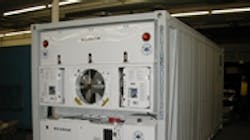Klinge reefer systems offer answer for hazardous cargo
Companies using intermodal containers to ship hazardous goods around the world are facing tougher safety standards for their shipments. In particular, shipping companies have been tightening procedures this year for temperature-sensitive hazardous and/or self-reactive cargo. Many are requiring use of recognized transport refrigeration equipment such as that produced by Klinge Corporation.
Amendments to the International Maritime Dangerous Goods Code came into force at the beginning of 2010 that have meant more materials being classified as “hazardous.”
Under the new rules, any substances that could potentially endanger vessels or pollute the marine environment are reclassified as “environmentally hazardous substances.” There are stricter requirements for labeling and transporting these hazardous shipments. Amended rules also include a number of new entries in the international Dangerous Goods List.
Shipping companies require hazardous substances from Class 4.1 up to Class 5.2 of the International Maritime Dangerous Goods code be transported in specialized temperature-controlled container systems, such as those manufactured by Klinge.
Hazardous loads are facing more and more checks from shipping companies and port authorities—including use of X-ray technology—to ensure safety for staff, the public, and the environment. Insurance providers may also now refuse to cover hazardous shipments that are not transported in recognized container systems.
Klinge, which is based in York PA, offers container refrigeration and heating systems for transport of hazardous materials. Containers feature microprocessor-based temperature controls, satellite tracking, and alarm monitoring systems.
•The Picture Frame Refrigeration Unit (PFR) Model 571 ZII-II offers explosion-proof motors and components designed to maintain space temperatures in Zone 2 hazardous locations.
•The Nose Mount Refrigeration Unit (NMR) dual refrigeration system Model 262 is designed for dangerous and temperature-sensitive cargo, offering primary and back-up temperature control systems to ensure complete and independent protection for shipments.
•Klinge’s Tank Container Refrigeration Unit (TCR) Model 104 is profiled to fit the shape of tank containers to maintain temperatures in liquid cargo.
For more information, call Sarah Klinge at 717-840-4500 or e-mail [email protected].
